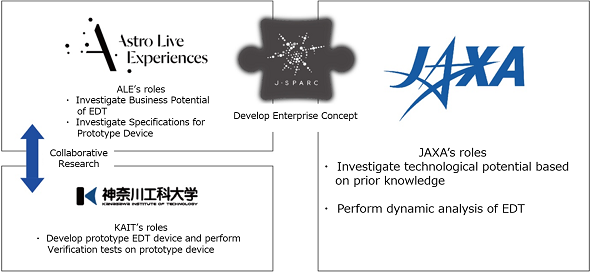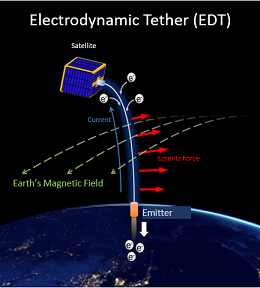ALE Co., Ltd Emphasizes its technological contribution to space debris mitigation
- Establishing a Partnership with JAXA on a new Business -
ALE, the space venture company, which currently develops space technologies and is on track to delivering the world’s first man-made meteors, will be developing a device to prevent the spreading of space debris with the Japanese Aerospace Exploration Agency (JAXA) under JAXA’s “JAXA Space Innovation through Partnership and Co-creation” (henceforth referred to as J-SPARC1) program. This announcement is to officially inform the world that ALE has started working on a concept co-creation to implement the space debris prevention device and strengthen its contribution to space debris mitigation.
Activity Overview
Due to the progress of space development and the increase of space objects, it is forecast that in the near future, space debris will self-propagate due to increased collisions between space objects (Kessler syndrome), generating space debris at an increasing pace. To tackle this burning issue, ALE partnered up with JAXA to develop a device that will perform post mission disposal (PMD) of microsatellite with an electro-dynamic tether (EDT). Together, ALE and JAXA will work to create a concept of a new space enterprise centered around this device.
By partnering with JAXA, who possesses a wealth of knowledge on EDT technology, ALE hopes to reduce the development time for this device and establish this enterprise as soon as possible.
In addition to partnering with JAXA, ALE will establish an academic-industrial collaboration with Kanagawa Institute of Technology (KAIT), who also has extensive research information on EDT technology. ALE and KAIT will study the critical parameters for the success of the EDT technology, such as the deployment timing during orbit and the kinematic behavior of highly elongated deorbiting objects. The role that each institution will play during development is summarized in the chart below.

Background for Starting of Activity
The miniaturization of satellites reduced their development and launching costs. The increasing number of satellites below 2000km altitude renewed the interest in establishing and securing a presence in low earth orbit (LEO). Compared to larger satellites in geostationary orbit, cheaper LEO satellites are designed for a shorter lifespan, thereby low-orbit satellite launches are expected to become increasingly frequent in the coming years. Additionally, a significant portion of low-orbit satellites cannot change their trajectories, and will aimlessly wander the LEO region until it re-enters the Earth’s atmosphere. The lifetime of these satellites can greatly vary; from several years to several centuries. Moreover, the final stages of the rockets that carry satellites remains in its orbit for a certain period, which worsens the situation. Thus, the probability that space objects will collide with one another increases each coming year.
About the Electrodynamic Tether
ALE started a co-creation project to develop a device harnessing EDT technology as a small yet effective solution to space debris as a central part of its new commercial venture. This small device will deploy a long tether in space and change the orbit of satellites by taking advantage of Earth’s magnetic field. JAXA own leading experts on EDT technology.
By placing this device on a satellite, once the mission is completed the satellite will be de-orbited and re-enters the Earth’s atmosphere automatically. Because this de-orbiting mechanism utilizes the Earth’s magnetic field, this device will properly function even if the satellite’s power supply system is faulted, thus preventing the satellite from turning into space debris. By pre-attaching this device on future microsatellites, the number of satellites that finished operation, or faulted satellites which are just floating in space can be greatly reduced. Additionally, by attaching an EDT device on the rocket as well, the remnants of the rocket can be disposed of as well.
We hope that as a result of our space enterprise, space will turn into a safer commercial platform and that space development will become more sustainable.

ALE’s strive for a more sustainable space development
By the joint realization of a miniature EDT device, it will be possible to place microsatellites at altitudes lower than the popular 500km-900km altitudes, allowing for both an extended range of altitudes for microsatellite as well as preventing the spread of space debris. As a result of these endeavors, we anticipate an accelerated development for space enterprises.
By implementing an electron source like the carbon nanotube electron emitter2 into the EDT system, the time required to bring the satellite to a lower altitude can be greatly reduced. Furthermore, it will also be possible for the satellite to maintain an extremely low altitude (below 400km) for a prolonged time, allowing microsatellites to operate at an extended range of altitudes.
In addition to the EDT device, ALE partnered with Tohoku University and Nakashimada Engineering Works Co. to co-develop the Membrane-Deployment De-Orbit Mechanism (DOM3) , which utilizes atmospheric drag to lower the satellite’s altitude. This DOM, like the EDT device, allows the satellite to quickly re-enter the atmosphere and be safely disposed. The DOM is currently aboard ALE’s own microsatellite.
ALE is looking to create more sustainable space development by creating solutions to both prevent the spreading of space debris and to increase the longevity of satellites in orbit.
*1:J-SPARC(JAXA Space Innovation through Partnership and Co-creation)is JAXA’s new research and development program which aims to create new space related businesses under partnership with companies that wish to develop/start new business in space. It also aims to develop technological innovations by gathering cutting-edge technologies, human expertise and private investments.
*22:An electron emission device that emits electrons by using the field emission effect.
*3:DOMR is a registered commercial product of Nakashimada Engineering Works Co.。
About ALE
ALE’s mission is to “Make Space closer. For all of us. Together.”
ALE mission is to bring space closer to people. ALE wishes to stimulate many of people’ curiosity to explore the infinite possibilities that space can offers.
Business Name: ALE Co., Ltd.
HQ Address:Kawamoto Building 2nd Floor 2-21-1 Akasaka, Minato-Ku, Tokyo, Japan
CEO:Lena Okajima
Founded:Sept 1, 2011
Business Overview:Part of the “Sky Canvas” Project, a Space Entertainment Enterprise using Man-made meteors and developing satellite technologies